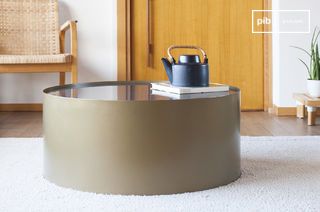Art Deco coffee tables
Art Deco coffee tables are characterized by an assertive geometric composition and the use of contrasting materials. Gilded metal, brass, glass, marble or dark wood structure rigid shapes, often centered, with restrained proportions. An art deco coffee table blends into architectural arrangements, with clean lines and controlled volumes. Its role goes beyond that of a support: it gives rhythm to space and organizes the eye around a central motif or material.
read more >Filters

Round marble coffee tableDickinson
€995 €895-10%
Formal criteria for an art deco coffee table
The art deco coffee table follows a precise geometric and ornamental logic. The shapes are often symmetrical, composed of circles, rectangles or octagons inscribed within a rigid structure. This formal rigor is counterbalanced by the use of rich materials and graphic details: metal edgings, marquetry, dark veneers or brass inserts. Each element is designed to reinforce the composition without excess.
Far from a free decorative style, art deco is based on a precise vocabulary: rhythm, right angles, repeated motifs. An art deco coffee table echoes these codes through its proportions and the organization of its components. It may rest on a solid base or on a sculpted pedestal, but the whole remains centered, frontal and oriented towards visual stability. This type of furniture imposes a certain rigor of arrangement, based on symmetry or contrast.
Materials used and associated visual effects
The materials of an art deco coffee table are never chosen at random. Marble or stained glass adds density and shine. The wood used is often dark (walnut, mahogany, ebony), sometimes lacquered, with a taut or satin finish. Metal is used for structure or detail: brass, gilded steel, anodized aluminum. Some models combine several materials in a single top, with deliberate contrasting effects (dark/light, smooth/textured).
The surface treatment is clean: no visible wear, no patina effect. Art deco aims for a precise, sometimes mirror-like finish that catches the light without diffusing it widely. This presupposes a controlled positioning in space, with well-considered lighting and particular care in the association with the other materials in the living room. The piece of furniture doesn't stand out: it attracts attention.
Agency, coherence and spatial role
An art deco coffee table doesn't stand alone. It fits into a marked environment: seats with clean lines, geometrically patterned rugs, sculpted lighting fixtures, furniture with solid legs or central shafts. It requires a little distance to be legible, especially in small spaces. The distance around the tabletop must be preserved, without peripheral overload. It's not a side table, it's a central piece in the visual composition.
White or neutral shades on the walls reinforce its formal impact, but it can also fit into a dense environment, provided a clear hierarchy is maintained between the elements. It supports objects, but not clutter: cubbies, books or floral arrangements must be placed with moderation. Every visible detail on its top contributes to the reading of the whole.
Choosing an art deco coffee table means integrating a structuring volume into an organized space. It doesn't suit every style, but asserts a clear direction: symmetry, contrast, legibility. It links materials and organizes space around a controlled fixed point.
